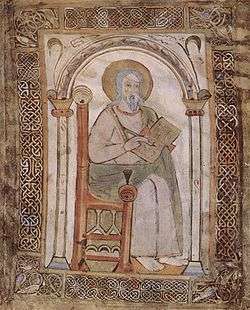Codex Eyckensis
The Codex Eyckensis is a manuscript dating from the first half of the 8th century. It is called “Eyckensis” because it was preserved during centuries in the convent of Aldeneik, near Maaseik, Belgium. In 1571 it became part of the church treasure of the Sint-Catharinakerk in Maaseik, Belgium. It is the oldest Gospel Book of the Benelux and is one of the earliest artistic creations in the form of a codex of the late Merovingian and early Carolingian period in this region.

According to an old legend this codex was written and illuminated by Saint Harlindis and Saint Relindis, sisters and foundresses of the convent of Aldeneik. But contrary to the legend, the book ends with a Latin text in which the scribe asks to pray for him. This text shows that the author was a man instead of the two holy sisters. This Latin text states 'Finito volumine deposco ut quicumque ista legerint pro laboratore huius operis depraecentur’ (translation: Now that I have finished this book, I ask with insistence that all those who will read this will pray for the "worker" of this manuscript) [1]
The manuscript contains the text of the four gospels in Latin, preceded by canon tables. These tables are divided in a number of parallel columns, indicating the concordant passages in the Gospels. They are put in an architectural frame of pillars and arches. The medallions with portraits of the Apostles at the middle of the main arch are characteristic for the Codex Eyckensis
The front page shows an Evangelist portrait, but it is uncertain which Evangelist is portrayed. It is believed to be the initial miniature of Matthew's Gospel. The pattern and the interlace around the figure is similar to that in the pages with the opening words of the Lindisfarne Gospels. The portrait is rendered in an Italian-Byzantine style.
The script and the style of the illuminations show that the Codex Eyckensis belongs the body of insular scripts. These codices were brought to the Continent by Irish and English missionaries in the seventh and eight centuries. The Codex Eyckensis was probably written in the scriptorium of the Abbey of Echternach, founded by saint Willibrord in the 7th century.
The Codex is now bound in two parts, because originally it consisted of two parts. The first part only contains five pages, consisting of the Evangelist portrait and canon tables. The second part consists of the complete canon tables and the Gospels.
Attempts to conserve the aging Codex in 1957, using a clear PVC coating, were later found to be damaging the parchment. [2] In 1990, a team from the Belgian Royal Institute for Cultural Heritage, led by Jan Wouters, removed the yellowing PVC laminate. [3] [4] [5]
The Codex is now on display in the St. Catherine church in Maaseik, Belgium. A high-resolution digitised copy of the manuscript is also available on line.
References
- ↑ Lindsay Wallace Martin, Palaeographia Latina; Georg Olms Verlag, 1989|p.30-31
- ↑ Wouters, Jan; Gancedo, Gely; Peckstadt, An; Watteeuw, Lieve, Grimstad, Kirsten, ed., "The Codex Eyckensis, an illuminated manuscript on parchment from the 8th century AD. Laboratory investigation and removal of a 30-year-old PVC lamination", ICOM Committee for Conservation, 9th triennial meeting, Dresden, German Democratic Republic, 26–31 August 1990: preprints: 495–499, ISBN 0-89236-185-9, retrieved 2010-06-23,
In 1957, the parchment of the Codex Eyckensis (8th century) was systematically laminated with the commercial plastic film, Mipofolie.
- ↑ Wouters, Jan (January–February 2008), "Reflections on the Position of Science in Multidisciplinary Approaches", Chemistry International, 30 (1), retrieved 2010-06-23,
High-level destructiveness analysis of synthetic membranes without touching the 8th century parchment of the Codex Eyckensis revealed a polyvinylchloride polymer with 30 % (w/w) monomeric plasticizer;
- ↑ Everts, Sarah (September 3, 2007), "Conservation At Arm's Length;Researchers at IUPAC congress advocate a measured approach to the conservation of cultural artifacts", Chemical & Engineering News, 85 (36): 43–45, doi:10.1021/cen-v085n036.p043, retrieved 2010-06-23,
In the '60s, people believed in the eternal existence of plastics
- ↑ Drastic measures save plastic treasures, pp. 42–45, retrieved 2010-06-23,
After just a few decades, the laminate had itself decayed, accelerating the destruction of the manuscripts. In 1990, a team led by Jan Wouters of the Royal Institute for Cultural Heritage in Brussels had to painstakingly peel away the PVC film (The Paper Conservator, vol 19, p 5).
- (French) J. Gielen, "Evangélaire d'Eyck du VIIIe siècle", Bulletin Koninklijke Commissie voor Kunst en Oudheden, 30, 1891, pp. 19–28.
- (French) D. De Bruyne, "L'évangéliaire du 8e s., conservé à Maeseyck", Bulletin de la Société d'Art et d'Histoire du Diocèse de Liège, 17, 1908, pp. 385–392.
- Christian Coppens, Albert Derolez, Hubert Heymans, Codex Eyckensis: An Insular Gospel Book from the Abbey of Aldeneik (Maaseik Town Council, c1994). ISBN 9002197764
External links
- Codex Eyckensis, online scans. Accessed 19 February 2016.
| Wikimedia Commons has media related to Maaseik Gospel Book. |